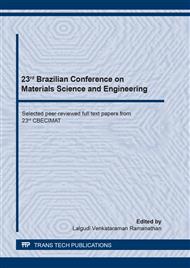p.84
p.89
p.94
p.100
p.109
p.114
p.119
p.125
p.131
Influence of Separator Thickness on the Performance of Electric Double Layer Supercapacitors in Aqueous Electrolyte
Abstract:
The effects of the separator thickness (δ) upon the equivalent series resistances (ESR) and specific capacitances (Cs) of supercapacitors electrodes have been investigated using commercially available porous filter paper (δ=150 μm, pores size=7.5 μm, 80 gm-2). Commercial activated carbon electrodes immersed in 1molL-1 KOH electrolyte (25°C) have been employed in this study. The specific capacitances were calculated from cyclic voltammetry curves at room temperature employing various scan rates (5, 10, 15 and 30 mVs-1). Internal series resistances of the supercapacitors were measured using the galvanostatic charge discharge curves also at room temperature. A maximum of 28 separators (δ=4200 μm) have been employed in this investigation. It has been shown that the ESR increases substantially with separator thickness (from 3.1 to 7.9 Ωcm2). The specific capacitance decreased somewhat with increasing separator thickness and scan rates (from 64 to 52 Fg-1; at 5 mVs-1). The microstructures of the electrode material have been investigated using scanning electron microscopy (SEM) and chemical microanalyses employing energy dispersive X-ray analysis (EDX). A compositional and morphological evaluation of these electrodes showed a very homogeneous microstructure.
Info:
Periodical:
Pages:
109-113
Citation:
Online since:
October 2020
Authors:
Price:
Сopyright:
© 2020 Trans Tech Publications Ltd. All Rights Reserved
Share:
Citation:


